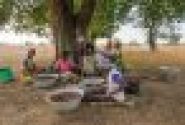
The Sustainable Development Goals need to recognise that forestry is broader than environmental protection – it also relates to poverty, food security, resilient landscapes and green growth. Mindy McAdams
Last week, the UN High-level Panel on Post-2015 Development Agenda met in Bali, Indonesia. The political commitment from last year’s Rio+20 conference to agree on a set of post-2015 goals addressing the broad challenges of poverty eradication, environmental protection and sustainable consumption and production (the Sustainable Development Goals, or SDGs) remains strong.
At the same time, there is a flurry of ideas on what the goals should be and how progress should be measured. Often these proposals come from organizations forwarding the topics that they are mandated to deal with. This can make it difficult to maintain an overview of what we would actually like to achieve in the future.
Despite the risk of adding to the confusion, here I provide some thoughts on a possible configuration of the SDGs, including a goal on landscapes. While the landscape topic is obviously close to the mandate of CIFOR and the CGIAR, the ambition in this blog is to provide some thoughts on how to broaden the perspective of the SDGs.
It is worth recalling that the SDG development process has already been much more ambitious than it was for the eight Millennium Development Goals (MDGs) that they are set to replace. The MDGs were not specified in the Millennium Declaration in 2000 – the goals, targets and indicators were prepared afterwards, based on general agreement. While the 2005 World Summit acknowledged the MDGs, it was as a set of a wider range of international development goals. It was only in 2010, that the UN General Assembly more firmly established the commitment to achieve the MDGs. In contrast, the SDG goals and targets are set to be agreed on upfront, hence the current attention that has been placed on the negotiation process.
Furthermore, the SDGs are expected to be less oriented to Official Development Assistance (ODA). By comparison, one of the MDGs (number 8 – “Develop a global partnership for development”) was dedicated to ODA. With a more generic approach to development, the SDGs can be more inclusive of the much larger investment potential from the private sector, as well as the public sector beyond ODA.
Finally, the MDGs were constructed in a way that does not always encourage cross-cutting contributions. Forests and forestry, for example, were parked under the environment goal, within the target related to reversing loss of environmental resources, and with the one indicator “Proportion of land area covered by forest”. Obviously, this does not convey the broader contributions of forests and forestry to development, including poverty, food security, resilient landscapes and green growth. Instead, this may have reinforced the view that forests are only about environmental protection.
With this background in mind, I’d now like to outline some thoughts on the configuration of the SDGs, and how a goal on landscapes could be defined.
Five is a good number for SDGs
– Defining SDGs and related global targets in a national and local priority setting is difficult because many special interests promote their own agendas. For example, developed countries’ institutions/politics often strongly advocate the environment dimension of sustainable development.
– Simplified, understandable, integrated and measurable goals/targets/parameters are needed.
- The MDG framework does not provide a convincing starting point.
- There should be no more than four to six SDGs.
– Political leadership is needed to cut across sectors/special interests and move on from the MDGs.
- Especially considering developing/emerging countries’ situation where the nexus of social, economic and environmental development is obvious and crucial.
– The rural economies including agriculture, forestry and fisheries have often been underrepresented in development frameworks such as the MDGs. Yet, they represent some of the largest issues and potentials for all dimensions of sustainable development in all regions.
– With the above in mind, a possible set of SDGs are:
- Sustainable landscapes (agriculture, forestry, fisheries, food, biodiversity, water, climate)
- Social protection (health services, rule of law, relief of food insecurity and extreme poverty)
- Green growth with equity (all economic sectors including finance, greenhouse gas emissions)
- Infrastructure for all (energy, roads, internet, markets, safe water and sanitation)
- Equal opportunities (gender, education, employment, human rights)
– Each goal could have its own development paradigm, allowing for some overlaps between the goals.
– Each goal could have a set of three to five targets, with one measure per target.
– Implementation of goals through targets, indicators, planning and investments should be scalable from global to local levels, and should be measureable at all levels and scales.
A goal on sustainable landscapes
– We need a new paradigm for development and environment that counteracts current silos between agriculture, forestry, fisheries and conservation.
– While the landscape concept is not new, it can be redefined to:
- Fit into the SDG framework as one of its goals.
- Connect to broader development goals such as poverty, food security, climate change, green growth, rights, governance and gender.
- Allow for clear and understandable measurements of progress:
- Generic landscape objectives, applicable anywhere.
- Few and scalable measurements against objectives.
- Find better solutions beyond neoclassical economic methods.
- Facilitate multi-objective, multi-stakeholder priority setting and planning
– With such a paradigm, we could also:
- Attract large scale private investments (with some publicly funded risk management)
- Advance land and resource tenure processes.
- Stimulate markets for the bio-based economy.
– Some requirements needed are:
- Application of political leadership to cut across silos at all levels
- E.g. Connect forestry and agriculture in the annual UNFCCC negotiations (don’t miss the Global Landscapes Forum at COP19 in Warsaw).
- Investment in long-term cross-cutting research to support evidence-based policies.
– Four proposed landscape objectives with performance measures are shown in the above figure.
- The performance measures are applicable anywhere at any scale, including the global scale.
- If all four are stable or improving, we can say that we have a sustainable landscape that contributes to development goals.
- These four objectives and performance measures can also be used to define targets, such as:
Target 1: Livelihood provisions: Farmer incomes to double by [year].
Target 2: Ecosystem services: Biomass in the landscape increase to [number] pentagrams (Pg) of carbon by [year].
Target 3: Products: Key staples and commodities supply increase by [number]% by [year]
Target 4: Resource efficiency: GHG emissions from landscape activities reduced by [number] Pg/year by [year]
This is, of course, only a contribution to the discussion; there are many views that need to be consolidated. CIFOR and its partners are currently working on landscape approaches as a way to find better solutions for the land-based sectors, working across the agriculture and forestry boundaries. Thinking about landscapes in the context of SDGs therefore comes naturally to us.
I look forward to a continued dialogue!
We want you to share Forests News content, which is licensed under Creative Commons Attribution-NonCommercial-ShareAlike 4.0 International (CC BY-NC-SA 4.0). This means you are free to redistribute our material for non-commercial purposes. All we ask is that you give Forests News appropriate credit and link to the original Forests News content, indicate if changes were made, and distribute your contributions under the same Creative Commons license. You must notify Forests News if you repost, reprint or reuse our materials by contacting forestsnews@cifor-icraf.org.













